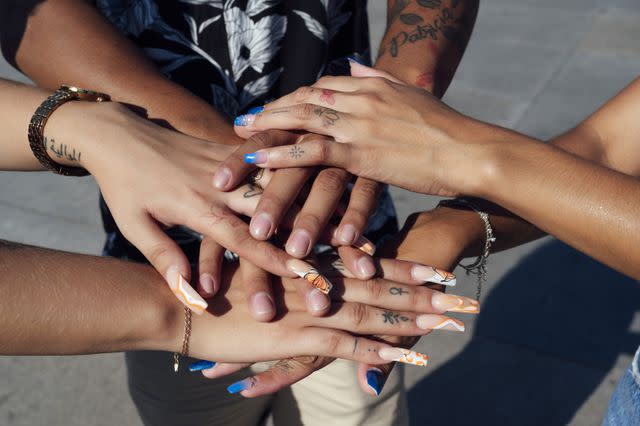How to Prepare for Getting a Tattoo

Getty Images
Getting a tattoo can be a meaningful way to express your identity and visually convey a message about who you are. It can be a tribute to your culture, challenges, memories, loved ones, or personal triumphs while adding a unique edge to your overall look.
If you’re considering getting a tattoo, finding an artist who meets your needs and deciding on the design and placement are essential. We tapped the experts to help you make the best choice and advice on mentally and physically preparing and caring for your tattoo session. Read on to learn how to prepare for a tattoo so you have no regrets over your permanent ink.
Meet Our Expert
Laura Schaack is the founder of Tattd, the first-ever booking engine for the tattoo industry.
Jingxi Gu is a popular L.A.-based tattoo artist at Patch Tattoo Therapy.
Finding a Reputable Tattoo Artist
Finding a reputable tattoo artist is paramount for satisfaction and safety, which should be your top priority. “You want to find an artist that is talented in the technical applications of tattooing while also maintaining a sanitary environment and proper customer service practices—your tattoo idea is only as good as the artist you choose to make it happen, so make that decision count,” says Schaack.
When selecting a tattoo artist, the first thing to do is to determine the style you want. A few popular genres include realism, stick and poke, Chinese painting, classic Americana, new school, and portraiture. Once you have decided on a style, search Instagram for tattoo artists who have displayed their work for several years and consistently produced high-quality work; don't just go by their most recent or popular tattoos.
“Look for accounts that have video clips of tattoos, as photos are easily photoshopped [and] some artists [do so] extensively, and [seek out] artists who have experience working on several areas of the body, as they will have broad experience in providing placement advice,” advises Gu.
When choosing a tattoo artist, Gu says it’s important to select someone who displays their healed tattoo work. Fresh tattoos don’t accurately reflect the artist’s skill in maintaining proper ink depth, which only becomes apparent after the healing process.
Tips
To ensure safety, Gu says to look for an artist who works in a legitimate facility with a publicly posted address and online reviews on platforms like Google or Yelp. This increases the likelihood that the tattoo studio follows health department regulations for equipment sanitation and processes. It also means that the studio has standards for maintaining quality customer service and tattoos.
If possible, visit the tattoo studio before you commit. Yes, you want a tattoo artist who does incredible work, but you also want one who is knowledgeable on blood-borne pathogens, cross contaminators, and, of course, being a professional. Shaack suggests asking yourself: Does the artist’s studio and setup look clean and sterile? Do they have clients who are posting positive reviews about both their work and treatment during the process? “Keep in mind, tattoos are permanent, and so is the experience you have while getting them, so make sure it’s memorable for the right reasons,” adds Schaack.
Finally, don’t limit yourself to local tattoo artists. “Remember, this is a lifelong tattoo, so it’s crucial to find an artist who resonates with you,” says Gu.

Getty Images
Deciding on Design and Placement
It’s important to have a clear idea of what you want and trust your artist’s expertise. Look for images online that accurately convey your idea. These images can help you communicate effectively with your artist, especially if you aren’t great with words.
Any tattoo design decisions need to consider the placement on the body first. This will help determine the size and shape of the tattoo that will fit the area well. According to Gu, start by discussing the concept and elements of the tattoo with the tattoo artist. Once the placement is confirmed, the size of the tattoo can be roughly assessed, and the design can be created. The artist may need to print out various sizes and mock it up on the body with a freehand pen or stencil.
Related: Everyone's Getting Dainty Tattoos Right Now
Remember, when it comes to tattoo designs, less is often more. “You don’t want to overload your design with detail or subject matters, as this can affect the readability of your tattoo, and if your tattoo artist tells you that your idea might be incorporating too much, listen to them and collaborate on a new iteration of your idea, advises Schaack.
When deciding on the location for your tattoo, it’s crucial to think about how it could affect your life based on its placement on your body. Although tattoos are becoming more widely accepted in society, they can still influence how others perceive you, particularly when it comes to potential employers. “Think twice about tattoos in prominent areas such as the neck, hands, or face if you’re not confident you won’t regret it later,” says Schaack.
When planning to get a stomach tattoo, it’s important to consider the impact it may have during pregnancy. Finger and foot tattoos may fade easily over time. If you want to cover up scars, it’s best to seek an experienced professional familiar with your skin type. These are all important factors to keep in mind, says Schaack. “Your tattoo artist will know the answers to all of your placement questions, so definitely trust them as they guide you on having the best tattoo ever,” she adds.
Preparing the Day Before
Once you're booked and ready, it’s important to take care of your body and mind to ensure a successful tattoo session. Schaack and Gu offer the following tips for the best experience.
Protect your skin: Avoid getting sunburned or injured before your appointment, as this could postpone the tattoo session.
No alcohol: refrain from consuming alcohol the night before and day of your appointment, as it can thin your blood and increase bleeding during the tattooing process.
Prioritize sleep: Get good sleep the night before so your body is ready for the physically stressful day ahead.
Eat a nutritious meal: In the hours leading up to your appointment, eat a substantial meal to keep your blood sugar regulated and prevent you from feeling ill during the appointment.
Focus on the rewards: While getting a tattoo can be painful, try to focus on the reward of enduring the discomfort.
Plan to rest: It’s best to plan for rest after your session to ensure both you and the artist are relaxed and not rushed. It’s also wise not to overtax yourself after the tattoo session so you can recover.

Getty Images
Tattoo Aftercare
Proper aftercare is crucial for tattoos to heal well and prevent infection. Once the tattoo session is done, the artist will apply a protective bandage over it. You must keep it on for three to 24 hours after your appointment or three to seven days if sticky protective bandages like Saniderm or Second Skin are used. This bandage will shield the skin while the tattoo begins to heal. “It is normal for the tattoo to look blurry under the bandage due to moisture accumulation caused by plasma building up and pulling up a small amount of ink," says Gu. "This is typical in the healing process, and your new tattoo will not look blurry after it heals.”
When it is time to take the bandage off, slowly remove the bandage under warm running water. It is normal to have to use a little bit of force to get the bandage off because it can stick tightly to the skin. “There may be a small amount of ink on the bandage, but this is nothing to worry about. It is caused by small micro-fragments of ink that dried on the bandage,” Gu explains.
In case the bandage starts to come off prematurely or causes any discomfort, Gu advises removing it as instructed above and applying an unscented lotion to the affected area. While washing the tattoo, use a mild soap and water and be gentle. She does not recommend scrubbing the tattoo with a brush or towel until it has fully healed. After washing, gently pat the tattooed area with a clean and sterile towel to dry it. Avoid applying a fresh bandage.
Related: How to Protect Your Tattoo and Keep It From Fading
Gu stresses the next few weeks are critical to healing. “After three days, the client should apply a light coating of Lubriderm, Aquaphor, H2Ocean, or Dermassage until the skin returns to its pre-tattoo condition,” she says. To ensure proper healing of your tattoo, avoid applying too much lotion, as it may pull up the ink, and only use a small amount to cover the area.
Tips
Refrain from direct sunlight and tanning booths for seven to 10 days as it may cause fading and dryness. Once healed, use sunscreen with at least SPF30 to protect your tattoo from UV rays and avoid exposing it to direct sunlight for a month after receiving it.
Gu recommends avoiding swimming or soaking in a tub or jacuzzi until the tattoo is completely healed. “Showers are safe, but do not submerge the area in water for long periods as it may cause infections,” she says. Do not use hydrogen peroxide or rubbing alcohol on the tattoo, as these products can slow the healing process and dry out the skin.
It’s also important to refrain from activities that make you sweat for about two weeks after receiving the tattoo. This includes avoiding unsanitary surfaces, tight clothing, and sweat, which may cause scarring and inflammation. Your tattoo should form a light, dry scab that will fall off in seven to 10 days—be sure not to touch or pick at the scab. If you follow all of these practices, trust your tattoo should look pristine.
For more InStyle news, make sure to sign up for our newsletter!
Read the original article on InStyle.

